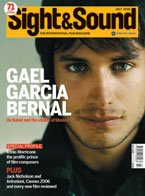
The July 2006 issue of SIGHT & SOUND is on newsstands this week, with Gael Garcia Bernál on the cover. In this month's issue, my "NoZone" column is devoted to the Zeitgeist Films DVD release, WRITER OF O, Pola Rapaport's extraordinary docudrama about Pauline Réàge, the pseudonymous author of the novel THE STORY OF O.
Speaking as a novelist, I find it very rare that any film accurately conveys the passion and interpersonal politics involved in writing fiction, but Ms. Rapaport's grasp of these was so knowing that I found her film an unexpectedly moving experience. Never before in the years I've been writing this column have I ever been motivated to seek out a filmmaker to express my feelings directly, but in this case I did, and I found Pola to be an appreciative and equally generous correspondent. In fact, I was so pleased by the response I got from Pola that I subsequently followed my emotions once again and wrote directly to Jonathan Weiss, the filmmaker responsible for the movie I'm reviewing in the August 2006 S&S, THE ATROCITY EXHIBITION.
I found both of these pictures to be fairly astonishing experiences, and especially in today's world, films made in a spirit of acute honesty and audacity and non-conformity need to be encouraged. Reviews alone would have done the trick, at least the usual trick, but something about the feelings these films awoke (or disturbed) in me encouraged me, for once (well, for twice) to step outside my usual professional boundaries and speak even more directly of their importance and impact to the people who made them.
I wish I had done this with Krzysztof Kieslowski when I first saw THE DOUBLE LIFE OF VERONIQUE, but a film like that (and all the ones that followed) struck me then and still strikes me as the work of a God. I am still astounded whenever I see archival footage of Kieslowski working or being interviewed and see evidence that he was like any number of other people I've known -- rumpled, underslept, carelessly dressed, smoking too much. It also astounds me that all of the amazing women who starred in his greatest films are a decade younger than I am, more or less -- not because I dupe myself into thinking I'm younger than I am, but because these films speak to me with the voice of eternity. They have a power and an inevitability and a perfection that seems to somehow pre-exist not only me, but everything.
Perfection in art has always had that effect on me, as has perfection in design. As a child, I had a terrible time absorbing beauty; I flinched from moments of beauty in movies as much as I hid my eyes during moments of horror. I actually hid my eyes during PINOCCHIO -- not when Lampwick was turning into the donkey (a scene I still find terrifying today), but whenever the Blue Fairy was on the screen, because she was so (too) radiantly beautiful. In the first grade, I can remember a time when the teacher rearranged our desks from the usual parallel queues into clusters of four -- two sets of desks facing one another. To my dismay, I was seated opposite the prettiest little girl in the class (I still remember her name, but I'm not telling you) and started spending all my time either looking down at my desktop or just past her head. If I looked up, I actually began to feel dizzy -- and this is first grade, mind you; it wasn't sexual, it was aesthetic, it was the frigging Stendhal Syndrome. I'm sure I must have feigned illness to skip school a few times just to spare myself those hours of emotional distress. It's a good thing I got over such aversions, but I still carry some emotional residue of them -- like this distance I've tended to impose on myself in regard to filmmakers I admire... or at least those whom I worship, as the case may be.
Perhaps my intense youthful reaction to beauty was the reason why Mario Bava's work spoke to me so directly, with its uncanny knack for tapping the beauty of horror and the ominous power of great beauty. One of my duties this week has been to give my Bava book a final read-through -- my first-ever read-through of an actual-size, illustrated print-out, so this is my first inkling of the power the book is going to have in its final presentation. The pages are in black-and-white at this point, but as I've been making my way through the pages, I have been revisited at times by that old PINOCCHIO feeling -- moved to deep and grateful emotion by the beauty of Bava's aesthetics, and by Donna's confident and potent presentation of my text and the other materials. To my surprise and gratification, I'm finding that reading this book conveys a feeling I never expected: the uncanny sensation of watching a movie.
Without leaving my house, without even loading a camera, I've made a movie too.